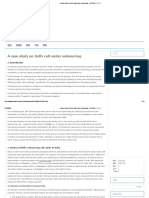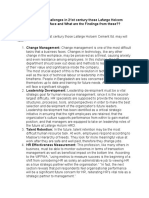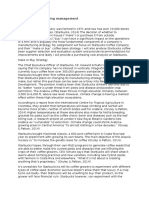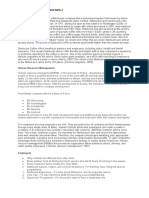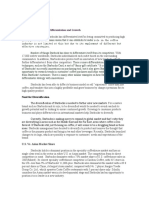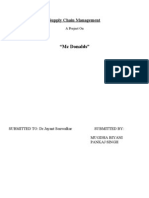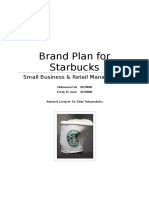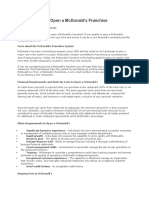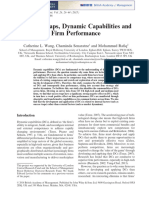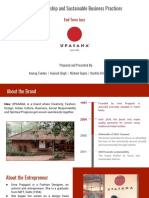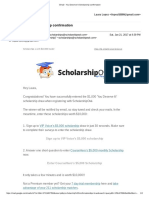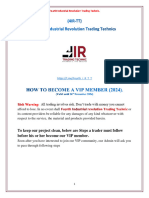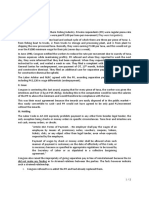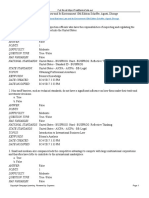Chapter 4
Chapter 4
Uploaded by
Clarisse Joyce Nava AbregosoCopyright:
Available Formats
Chapter 4
Chapter 4
Uploaded by
Clarisse Joyce Nava AbregosoCopyright
Available Formats
Share this document
Did you find this document useful?
Is this content inappropriate?
Copyright:
Available Formats
Chapter 4
Chapter 4
Uploaded by
Clarisse Joyce Nava AbregosoCopyright:
Available Formats
OM2
CHAPTER 4
OPERATIONS STRATEGY
DAVID A. COLLIER
AND
JAMES R. EVANS
OM2, Ch. 4 Operations Strategy
2010 Cengage Learning. All Rights Reserved. May not be scanned, copied or duplicated, or
posted to a publicly accessible website, in whole or in part.
Chapter 4 Learning Outcomes
learning outcomes
LO1 Explain how organizations seek to gain
competitive advantage.
LO2 Explain approaches for understanding
customer
requirements.
LO3 Describe how customers evaluate goods and
services.
LO4 Explain the five key competitive priorities.
LO5 Explain the role of OM and operations
strategy in
strategic planning.
OM2, Ch. 4 Operations Strategy
2010 Cengage Learning. All Rights Reserved. May not be scanned, copied or duplicated, or
posted to a publicly accessible website, in whole or in part.
LO6 Describe Hills framework for operations
22
Chapter 4 Operations Strategy
ival golf club equipment manufacturers TaylorMade and
Callaway are
both based in Carlsbad, California. Thats about where the
similarity
ends. Callaway made clubs for average golfers, while
TaylorMade took
the clubs pro golfers were using and adjusted them to suit amateurs.
Callaway focused on management and production efficiency while
sticking to core product designs, much the way Ford built cars around a
basic chassis. TaylorMade, however, was constantly reinventing its
products lines, and in an industry that expected product cycles to last
18 months or longer, began releasing new drivers and irons in rapid-fire
succession. Even new product launches show the difference between
these companies: Callaway typically launched products with lengthy
What
do you
think? Whatwhile
implications
would
the different
PowerPoint
presentations,
TaylorMade
turned
them intostrategies
huge pep
chosen
Callaway and
TaylorMade
sticking
to core
designs
rallies. by
TaylorMades
strategy
seemsto
have paid
off; product
late in 2003
it
versus
continual
innovation
have for
operations management
overtook
Callaway
in market share
for key
metalwoods.
decisions such as outsourcing and designing flexibility into their
processes?
OM2, Ch. 4 Operations Strategy
2010 Cengage Learning. All Rights Reserved. May not be scanned, copied or duplicated, or
posted to a publicly accessible website, in whole or in part.
33
Chapter 4 Operations Strategy
What implications would the different strategies
chosen by Callaway and TaylorMade sticking to
core product designs versus continual innovation
have for key operations management decisions
such as outsourcing and designing flexibility into
their processes? (Consider the decision areas
discussed in Chapter 2 for designing value
chains.)
Should organizations create strategies in
response to customer wants and needs, or
should they create strategies and then try to
influence customer behavior to meet the
strategic goals?
OM2, Ch. 4 Operations Strategy
2010 Cengage Learning. All Rights Reserved. May not be scanned, copied or duplicated, or
posted to a publicly accessible website, in whole or in part.
44
Chapter 4 Operations Strategy
Competitive Priorities
Competitive advantage denotes a
firms ability to achieve market and
financial superiority over its
competitors.
Competitive priorities represent the
strategic emphasis that a firm places on
certain performance measures and
operational capabilities within a value
chain.
OM2, Ch. 4 Operations Strategy
2010 Cengage Learning. All Rights Reserved. May not be scanned, copied or duplicated, or
posted to a publicly accessible website, in whole or in part.
55
Chapter 4 Operations Strategy
Understanding Customer Requirements
A Japanese professor, Noriaki Kano, suggested
three classes of customer requirements:
Dissatisfiers: requirements that are expected in
a good or service. If these features are not
present, the customer is dissatisfied, sometimes
very dissatisfied.
Satisfiers: requirements that customers say
they want.
Exciters/delighters: new or innovative good or
service features that customers do not expect.
Examples?
OM2, Ch. 4 Operations Strategy
2010 Cengage Learning. All Rights Reserved. May not be scanned, copied or duplicated, or
posted to a publicly accessible website, in whole or in part.
66
Chapter 4 Operations Strategy
Understanding Customer Requirements
Basic customer expectationsdissatisfiers
and satisfiersare generally considered
the minimum performance level required
to stay in business and are often called
order qualifiers.
Order winners are goods and service
features and performance characteristics
that differentiate one customer benefit
package from another, and win the
customer's business.
OM2, Ch. 4 Operations Strategy
2010 Cengage Learning. All Rights Reserved. May not be scanned, copied or duplicated, or
posted to a publicly accessible website, in whole or in part.
77
Chapter 4 Operations Strategy
Understanding Customer Requirements
Search attributes are those that a
customer can determine prior to purchasing
the goods and/or services. These attributes
include things like color, price, freshness,
style, fit, feel, hardness, and smell.
Goods such as supermarket food, furniture,
clothing, automobiles, and houses are high
in search attributes.
OM2, Ch. 4 Operations Strategy
2010 Cengage Learning. All Rights Reserved. May not be scanned, copied or duplicated, or
posted to a publicly accessible website, in whole or in part.
88
Chapter 4 Operations Strategy
Understanding Customer Requirements
Experience attributes are those that can
be discerned only after purchase or during
consumption or use.
Examples of these attributes are
friendliness, taste, wearability, safety, fun,
and customer satisfaction.
OM2, Ch. 4 Operations Strategy
2010 Cengage Learning. All Rights Reserved. May not be scanned, copied or duplicated, or
posted to a publicly accessible website, in whole or in part.
99
Chapter 4 Operations Strategy
Understanding Customer Requirements
Credence attributes are any aspects of a
good or service that the customer must
believe in, but cannot personally evaluate
even after purchase and consumption.
Examples would include the expertise of a
surgeon or mechanic, the knowledge of a
tax advisor, or the accuracy of tax
preparation software.
OM2, Ch. 4 Operations Strategy
2010 Cengage Learning. All Rights Reserved. May not be scanned, copied or duplicated, or
posted to a publicly accessible website, in whole or in part.
1010
Exhibit 4.1
How Customers Evaluate Goods and Services
OM2, Ch. 4 Operations Strategy
2010 Cengage Learning. All Rights Reserved. May not be scanned, copied or duplicated, or
posted to a publicly accessible website, in whole or in part.
1111
Chapter 4 Operations Strategy
Customers evaluate services in ways that are often
different from goods, such as:
Customers seek and rely more on information from personal
sources than from non-personal sources when evaluating
services prior to purchase.
Customers use a variety of perceptual features in evaluating
services.
Customers normally adopt innovations in services more
slowly than they adopt innovation in goods.
Customers perceive greater risks when buying services than
when buying goods.
Dissatisfaction with services is often the result of customers
inability to properly perform or co-produce their part of the
service.
These insights help to explain why it is more difficult to design
services and service processes than goods and manufacturing
OM2, Ch. 4 Operations Strategy
2010
Cengage Learning. All Rights Reserved. May not be scanned, copied or duplicated, or
operations.
posted to a publicly accessible website, in whole or in part.
1212
Chapter 4 Operations Strategy
Competitive Priorities
Cost
Quality
Time
Flexibility
Innovation
OM2, Ch. 4 Operations Strategy
2010 Cengage Learning. All Rights Reserved. May not be scanned, copied or duplicated, or
posted to a publicly accessible website, in whole or in part.
1313
Chapter 4 Operations Strategy
Competitive Priorities
Every organization is concerned with
building and sustaining a competitive
advantage in its markets (see BMW).
A strong competitive advantage is driven
by customer needs and aligns the
organization's resources with its business
opportunities.
A strong competitive advantage is difficult
to copy, often because of a firms culture,
habits, or sunk costs.
OM2, Ch. 4 Operations Strategy
2010 Cengage Learning. All Rights Reserved. May not be scanned, copied or duplicated, or
posted to a publicly accessible website, in whole or in part.
1414
Chapter 4 Operations Strategy
Competitive Priority Cost
Almost every industry has a low price market
segment.
Low-cost strategy firms: Honda Motor Co.,
Marriott's Fairfield Inns, Merck-Medco Online Pharmacy, Southwest Airlines, and
Wal-Mart's Sam's Club.
Southwest Airlines is one of the few airlines
that have been profitable during the 20012005 period. A low cost strategy can reshape
industry structure such as in the airline
industry (see Southwest Airlines).
OM2, Ch. 4 Operations Strategy
2010 Cengage Learning. All Rights Reserved. May not be scanned, copied or duplicated, or
posted to a publicly accessible website, in whole or in part.
1515
Chapter 4 Operations Strategy
Coffee Wars
Starbucks is facing growing competition from
competitors like Dunkin Donuts and McDonalds for a
good and inexpensive cup of coffee. McDonalds
introduced premium roast coffee a few years ago,
which was cited by Consumer Reports as the
cheapest and best. More recently, it has also
added separate coffee bars McCafes. --- Now
Starbucks is fighting back and playing the
McDonalds game: Starbucks is testing a $1 cup of
coffee with free refills in the Seattle area. The CEO of
Starbucks, Howard Schultz, says this is not a new
strategy but that he believes that price is the number
one competitive priority and that Starbucks lost its
focus on customer service in recent years as it
OM2, Ch. 4 Operations Strategy
2010 Cengage Learning. All Rights Reserved. May not be scanned, copied or duplicated, or
1616
concentrated on growth.
posted to a publicly accessible website, in whole or in part.
Chapter 4 Operations Strategy
Competitive Priority Quality
PIMS Associates, Inc., a subsidiary of the Strategic
Planning
Institute, found that:
Businesses offering premium quality goods usually
have large market shares and were early entrants
into their markets.
Quality is positively and significantly related to a
higher return on investment for almost all kinds of
market situations.
A strategy of quality improvement usually leads to
increased market share, but at a cost in terms of
reduced short-run profitability.
High goods quality producers can usually charge
premium prices.
OM2, Ch. 4 Operations Strategy
2010 Cengage Learning. All Rights Reserved. May not be scanned, copied or duplicated, or
posted to a publicly accessible website, in whole or in part.
1717
Exhibit 4.2
Interlinking Quality and Profitability Performance
OM2, Ch. 4 Operations Strategy
2010 Cengage Learning. All Rights Reserved. May not be scanned, copied or duplicated, or
posted to a publicly accessible website, in whole or in part.
1818
Chapter 4 Operations Strategy
Competitive Priority Time
Time is perhaps the most important
source of competitive advantage.
Customers demand quick response, short
waiting times, and consistency in
performance.
Many firms use time as a competitive
weapon to create and deliver superior
goods and services, such as Charles
Schwab, Clarke American Checks,
CNN, Dell, FedEx, and Wal-Mart.
OM2, Ch. 4 Operations Strategy
2010 Cengage Learning. All Rights Reserved. May not be scanned, copied or duplicated, or
posted to a publicly accessible website, in whole or in part.
1919
Chapter 4 Operations Strategy
Competitive Priority Time
Reductions in flow time serve two purposes:
First, they speed up work processes so
that customer response is improved.
Deliveries can be made faster, and more
often on-time.
Second, reductions in flow time can be
accomplished only by streamlining and
simplifying processes and value chains to
eliminate non-value-added steps such as
rework and waiting time.
OM2, Ch. 4 Operations Strategy
2010 Cengage Learning. All Rights Reserved. May not be scanned, copied or duplicated, or
posted to a publicly accessible website, in whole or in part.
2020
Chapter 4 Operations Strategy
Competitive Priority Time
Flow time reductions often drive
simultaneous improvements in quality,
cost, and productivity (see Hyundai Motor
Co.).
OM2, Ch. 4 Operations Strategy
2010 Cengage Learning. All Rights Reserved. May not be scanned, copied or duplicated, or
posted to a publicly accessible website, in whole or in part.
2121
Chapter 4 Operations Strategy
Competitive Priority Flexibility
Mass customization is being able to
make whatever goods and services the
customer wants, at any volume, at any
time for anybody, and for a global
organization, from any place in the world.
OM2, Ch. 4 Operations Strategy
2010 Cengage Learning. All Rights Reserved. May not be scanned, copied or duplicated, or
posted to a publicly accessible website, in whole or in part.
2222
Chapter 4 Operations Strategy
Competitive Priority Flexibility
Mass customization requires companies to
align their activities around differentiated
customer segments and to design goods,
services, and operations around flexibility.
High-levels of flexibility might require
special strategies such as modular
designs, interchangeable components,
and postponement strategies.
OM2, Ch. 4 Operations Strategy
2010 Cengage Learning. All Rights Reserved. May not be scanned, copied or duplicated, or
posted to a publicly accessible website, in whole or in part.
2323
Chapter 4 Operations Strategy
Competitive Priority Flexibility
Flexible operations require sharing
manufacturing lines and specialized
training for employees.
Flexible operations may also require
attention to outsourcing decisions,
agreements with key suppliers, and
innovative partnering arrangements,
because delayed shipments and a
complex supply chain can hinder
flexibility.
OM2, Ch. 4 Operations Strategy
2010 Cengage Learning. All Rights Reserved. May not be scanned, copied or duplicated, or
posted to a publicly accessible website, in whole or in part.
2424
Chapter 4 Operations Strategy
Competitive Priority Flexibility
Examples include:
Sign-tic company signs that are uniquely
designed for each customer from a standard
base sign structure
business consulting
Levis jeans that are cut to exact measurements
personal Web pages
estate planning
Harley-Davidson bikes
cell phones customized in different colors, sizes,
and shapes
personal weight training programs
modular furniture that customers can configure
OM2, Ch. 4 Operations Strategy
2010 Cengage Learning.
Rights Reserved.
May not be scanned,
copied or duplicated,
toAlltheir
unique
needs
andortastes
2525
posted to a publicly accessible website, in whole or in part.
Chapter 4 Operations Strategy
Competitive Priority Innovation
Innovation is the discovery and
practical application or
commercialization of a device,
method, or idea that differs from
existing norms.
Innovations in all forms encapsulate
human knowledge.
OM2, Ch. 4 Operations Strategy
2010 Cengage Learning. All Rights Reserved. May not be scanned, copied or duplicated, or
posted to a publicly accessible website, in whole or in part.
2626
Chapter 4 Operations Strategy
Competitive Priority Innovation
Innovations take many forms, such as:
Physical goods such as telephones,
automobiles, refrigerators,
computers, optical fiber, satellites,
and cell phones.
Services such as self-service, all-suite
hotels, health maintenance
organizations, and Internet banking.
OM2, Ch. 4 Operations Strategy
2010 Cengage Learning. All Rights Reserved. May not be scanned, copied or duplicated, or
posted to a publicly accessible website, in whole or in part.
2727
Chapter 4 Operations Strategy
Competitive Priority Innovation
Innovations take many forms, such as:
Manufacturing such as computer-aided
design, robotic automation, and smart
tags.
Management practices such as
customer satisfaction surveys,
quantitative decision models, and Six
Sigma.
OM2, Ch. 4 Operations Strategy
2010 Cengage Learning. All Rights Reserved. May not be scanned, copied or duplicated, or
posted to a publicly accessible website, in whole or in part.
2828
Chapter 4 Operations Strategy
Solved Problem
Define the customer benefit package for a health
club or recreation center and use this to describe
the organizations strategic mission, strategy,
competitive priorities, and how it wins customers.
OM2, Ch. 4 Operations Strategy
2010 Cengage Learning. All Rights Reserved. May not be scanned, copied or duplicated, or
posted to a publicly accessible website, in whole or in part.
2929
Chapter 4 Operations Strategy
Solution
Child
Care
Mission: The mission of our
Personal
Trainer
Food
Exercise
Classes
Healthy
Mind and
Diet and
Body
Nutrition
Swim
health club is to offer many
Massage
Lessons
Services
pathways to a healthy living style
and body.
Strategy: We strive to provide our customers
with superior:
Customer convenience (location, food,
communication, schedules, etc.)
Clean facilities, equipment, uniforms, parking
lot, and the like
Friendly professional staff that care about you
Ways to improve and maintain your body and
mind's health and well being
OM2, Ch. 4 Operations Strategy
2010 Cengage Learning. All Rights Reserved. May not be scanned, copied or duplicated, or
posted to a publicly accessible website, in whole or in part.
3030
Chapter 4 Operations Strategy
Solution - continued
How to win customers? Providing a full
service health club with superior service,
staff, and facilities.
Competitive Priorities:
1. Many pathways to healthy living and a
healthy body (design flexibility)
2. Friendly professional staff and service
encounters (service quality)
3. Everything is super-clean (goods and
environmental quality)
4. Customer convenience in all respects
(time)
5. Price (cost)
OM2, Ch. 4 Operations Strategy
2010 Cengage Learning. All Rights Reserved. May not be scanned, copied or duplicated, or
posted to a publicly accessible website, in whole or in part.
3131
Chapter 4 Operations Strategy
Solution - continued
Example Health Club Processes
The food ordering and supply, preparation, delivery,
and clean-up processes define the food service value
chain.
The childcare process includes rigorous procedures
for checking children in and out of the childcare area.
The swimming lesson process includes a sign-up
phase, potential participant medical examination phase,
and a series of classes taught by certified swimming
instructors who are trained in emergency services such
as CPR.
The personal trainer process requires high design
flexibility, since each exercise and training program is
OM2, Ch. 4 Operations
Strategy
customized
to the individual.
2010 Cengage Learning. All Rights Reserved. May not be scanned, copied or duplicated, or
posted to a publicly accessible website, in whole or in part.
3232
Chapter 4 Operations Strategy
Strategic Planning
Strategy is a pattern or plan that
integrates an organizations major goals,
policies, and action sequences into a
cohesive whole.
Effective strategies develop around a few
key competitive priorities, such as low cost
or fast service time, which provide a focus
for the entire organization and exploit an
organizations core competencies (the
strengths unique to that organization).
OM2, Ch. 4 Operations Strategy
2010 Cengage Learning. All Rights Reserved. May not be scanned, copied or duplicated, or
posted to a publicly accessible website, in whole or in part.
3333
Chapter 4 Operations Strategy
Strategic Planning
Strategic planning is the process of
determining long-term goals, policies, and
plans for an organization.
The businesses in which the firm will
participate are often called strategic
business units (SBUs), and are usually
defined as families of goods or services
having similar characteristics or methods of
creation.
Strategy is the result of a series of
hierarchical decisions about goals, directions,
3434
and resources.
OM2, Ch. 4 Operations Strategy
2010 Cengage Learning. All Rights Reserved. May not be scanned, copied or duplicated, or
posted to a publicly accessible website, in whole or in part.
Chapter 4 Operations Strategy
Strategic Planning
Most large organizations have three levels
of strategy:
Corporate strategy is necessary to
define the businesses in which the
corporation will participate and develop
plans for the acquisition and allocation
of resources among those businesses.
OM2, Ch. 4 Operations Strategy
2010 Cengage Learning. All Rights Reserved. May not be scanned, copied or duplicated, or
posted to a publicly accessible website, in whole or in part.
3535
Chapter 4 Operations Strategy
Strategic Planning
Most large organizations have three levels
of strategy:
A business strategy defines the focus
for SBUs. The major decisions involve
which markets to pursue and how best to
compete in those markets; that is, what
competitive priorities the firm should
pursue.
OM2, Ch. 4 Operations Strategy
2010 Cengage Learning. All Rights Reserved. May not be scanned, copied or duplicated, or
posted to a publicly accessible website, in whole or in part.
3636
Chapter 4 Operations Strategy
Strategic Planning
Most large organizations have three levels
of strategy:
A functional strategy is the set of
decisions that each functional area
marketing, finance, operations, research
and development, engineering, and so on
develops to support its particular
business strategy.
OM2, Ch. 4 Operations Strategy
2010 Cengage Learning. All Rights Reserved. May not be scanned, copied or duplicated, or
posted to a publicly accessible website, in whole or in part.
3737
Chapter 4 Operations Strategy
Strategic Planning
The operations strategy defines
how an organization will execute its
chosen business strategies.
It is how an organizations processes
are designed and organized to produce
the type of goods and services to
support the corporate and business
strategies.
OM2, Ch. 4 Operations Strategy
2010 Cengage Learning. All Rights Reserved. May not be scanned, copied or duplicated, or
posted to a publicly accessible website, in whole or in part.
3838
Chapter 4 Operations Strategy
Strategic Planning
Managers recognize that the value
(supply) chain can be leveraged to provide
a distinct competitive advantage, and that
operations is a core competency for
the organization.
Whoever has superior operational
capability over the long term is the oddson-favorite to win the industry shakeout.
OM2, Ch. 4 Operations Strategy
2010 Cengage Learning. All Rights Reserved. May not be scanned, copied or duplicated, or
posted to a publicly accessible website, in whole or in part.
3939
Chapter 4 Operations Strategy
Pals Strategic Planning Process
Values are attitudes and policies for all
employees to follow that direct the
journey to achieving the organizations
vision.
Values are reinforced through conscious
and subconscious behavior at all levels of
the organization.
OM2, Ch. 4 Operations Strategy
2010 Cengage Learning. All Rights Reserved. May not be scanned, copied or duplicated, or
posted to a publicly accessible website, in whole or in part.
4040
Chapter 4 Operations Strategy
Pals Strategic Planning Process
The strategic mission of a firm defines its
reason for existence.
The strategic vision describes where the
organization is headed and what it
Vision Statement
intends to be.
To be the preferred quick service restaurant
in our market achieving the largest market
share by providing:
The quickest, friendliest, most accurate
service available
Pals strategic vision is
A focused menu that delights customers
Daily excellence in our product, service,
and systems execution
Clean, organized, sanitary facilities
Exceptional value
OM2, Ch. 4 Operations Strategy
2010 Cengage Learning. All Rights Reserved. May not be scanned, copied or duplicated, or
posted to a publicly accessible website, in whole or in part.
4141
Chapter 4 Operations Strategy
Pals Operations Strategy
What kind of an operations strategy might a company
like Pals Sudden Service have? What are the OM
implications?
The quickest, friendliest, most accurate service
available.
A focused menu that delights customers.
Daily excellence in product, service, and systems
execution.
Clean, organized, sanitary facilities.
Exceptional value.
OM2, Ch. 4 Operations Strategy
2010 Cengage Learning. All Rights Reserved. May not be scanned, copied or duplicated, or
posted to a publicly accessible website, in whole or in part.
4242
Chapter 4 Operations Strategy
Professor Terry Hills Strategy Development Framework
Operations design choices are the decisions
management must make as to what type of process
structure is best suited to produce goods or create
services. (See Exhibits 4.3 and 4.4)
Types of processes and alternative designs
Supply chain integration and outsourcing
Technology
Capacity and facilities (size, timing, location)
Inventory
Trade-off analysis
OM2, Ch. 4 Operations Strategy
2010 Cengage Learning. All Rights Reserved. May not be scanned, copied or duplicated, or
posted to a publicly accessible website, in whole or in part.
4343
Exhibit 4.3
Hills Strategy Development Framework
Source: T. Hill, Manufacturing Strategy: Text and Cases, 2nd ed., Burr Ridge, IL: Irwin Publishers, 1994, p. 28
OM2, Ch. 4 Operations Strategy
2010 Cengage Learning. All Rights Reserved. May not be scanned, copied or duplicated, or
posted to a publicly accessible website, in whole or in part.
4444
Chapter 4 Operations Strategy
Professor Terry Hills Strategy Development Framework
Infrastructure focuses on the nonprocess
features and capabilities of the organization
(see Exhibits 4.3 and 4.4) and includes:
workforce
operating plans and control system(s)
quality control
organizational structure
compensation systems
learning and innovation systems
support services
OM2, Ch. 4 Operations Strategy
2010 Cengage Learning. All Rights Reserved. May not be scanned, copied or duplicated, or
posted to a publicly accessible website, in whole or in part.
4545
Exhibit 4.4
Four Key Decision Loops in Terry Hills Generic Strategy Framework
OM2, Ch. 4 Operations Strategy
2010 Cengage Learning. All Rights Reserved. May not be scanned, copied or duplicated, or
posted to a publicly accessible website, in whole or in part.
4646
Chapter 4 Operations Strategy
Professor Hills Strategy Framework Applied to McDonalds
McDonald's vision is to be the world's best quick
service restaurant experience. Being the best
means providing outstanding quality, service,
cleanliness, and
value, so that we make every customer in every
restaurant smile. To achieve our vision, we focus on
three worldwide strategies:
(1) Be the Best Employer
(2) Deliver Operational Excellence
(3) Achieve Enduring Profitable Growth
Customer Benefit Package Design and Strategy (see
Ex. 4.5)
Strategy Development for McDonalds (see Exhibit
OM2, Ch. 4 Operations Strategy
2010 Cengage Learning. All Rights Reserved. May not be scanned, copied or duplicated, or
posted to a publicly accessible website, in whole or in part.
4747
Exhibit 4.5
McDonalds Customer Benefit Package
OM2, Ch. 4 Operations Strategy
2010 Cengage Learning. All Rights Reserved. May not be scanned, copied or duplicated, or
posted to a publicly accessible website, in whole or in part.
4848
Exhibit 4.6
Applying Hills Strategy Development Framework to McDonalds
(slide 1)
OM2, Ch. 4 Operations Strategy
2010 Cengage Learning. All Rights Reserved. May not be scanned, copied or duplicated, or
posted to a publicly accessible website, in whole or in part.
4949
Exhibit 4.6
Applying Hills Strategy Development Framework to McDonalds
(slide 2)
OM2, Ch. 4 Operations Strategy
2010 Cengage Learning. All Rights Reserved. May not be scanned, copied or duplicated, or
posted to a publicly accessible website, in whole or in part.
5050
Chapter 4 Operations Strategy
The Lawn Care Company Case Study
1. Define Lawn Cares current strategic mission, strategy,
competitive priorities, value chain, and how it wins customers.
What are the order qualifiers and winners?
2. Draw the major stages of the value chain with and without an
application service and comment on the role of operations in
each.
3. What problems, if any, do you see with Lawn Cares current
strategy, vision, customer benefit package and value chain
design, and pre- and post-services?
4. What pre- and post-services could Lawn Care offer its
customers to complement the sale of its physical goods, such as
grass seed and fertilizer?
5. Redo questions (1) to (4) and provide a new or revised strategy
and associated customer benefit package and value chain where
services play a larger role.
6. What are your final recommendations?
OM2, Ch. 4 Operations Strategy
2010 Cengage Learning. All Rights Reserved. May not be scanned, copied or duplicated, or
posted to a publicly accessible website, in whole or in part.
5151
You might also like
- Assignment 3the Case of 19011 PharmaciesDocument5 pagesAssignment 3the Case of 19011 Pharmacieshanan67% (3)
- A case study on Dell's call center outsourcing - lei1016cn - 博客园Document13 pagesA case study on Dell's call center outsourcing - lei1016cn - 博客园Han JeeNo ratings yet
- History of Pret A MangerDocument10 pagesHistory of Pret A MangerAnaMaria DragomirNo ratings yet
- Motivation of StarbucksDocument6 pagesMotivation of StarbucksAnê Xuân HươngNo ratings yet
- DraftDocument8 pagesDraftJeffery MillefioreNo ratings yet
- Ken Le - Marketing PlanDocument4 pagesKen Le - Marketing Planapi-517699380No ratings yet
- Costa CoffeeDocument14 pagesCosta CoffeeBűķhāŕï Hėñå67% (3)
- My Solution Pret A MangerDocument1 pageMy Solution Pret A MangerMaha KhanNo ratings yet
- Product Satisfaction and Its Effect On Customer LoyaltyDocument42 pagesProduct Satisfaction and Its Effect On Customer LoyaltyAdele Barnard100% (1)
- What Are The HRM Challenges in 21st Century Those Lafarge Holcem Cement LTDDocument7 pagesWhat Are The HRM Challenges in 21st Century Those Lafarge Holcem Cement LTDMd Borhan Uddin 2035097660100% (1)
- Stretegic CadburyDocument20 pagesStretegic CadburyWalid Mohamed AnwarNo ratings yet
- 3 5Document2 pages3 5Ngọc PhụngNo ratings yet
- Forex Trading System - Jaco Ferreira PDFDocument64 pagesForex Trading System - Jaco Ferreira PDFAwonke Goso100% (2)
- Switching Cost of BFC and KFCDocument11 pagesSwitching Cost of BFC and KFCMohammad ShibliNo ratings yet
- Report (Starbuck Text)Document18 pagesReport (Starbuck Text)Goharz2No ratings yet
- Case: Motivating Partners at StarbucksDocument2 pagesCase: Motivating Partners at StarbucksJe AnnNo ratings yet
- Starbucks Recruiting, Compensation, and BenefitsDocument19 pagesStarbucks Recruiting, Compensation, and BenefitsKiki 'Khadija' Rizki100% (2)
- Risk Management (Starbucks) G3Document8 pagesRisk Management (Starbucks) G3Chaddy Kayle MimbalawagNo ratings yet
- Mcdonalds in IndiaDocument20 pagesMcdonalds in IndiaAnupam KhandreNo ratings yet
- Starbucks Vs MC Donald'sDocument4 pagesStarbucks Vs MC Donald'sAaditya Reborn ZeusNo ratings yet
- Compiled by - Tanya (BFT/18/639) : Assignment 1Document12 pagesCompiled by - Tanya (BFT/18/639) : Assignment 1TANYA TANYANo ratings yet
- Starbucks Purchasing ManagementDocument6 pagesStarbucks Purchasing ManagementnajihahNo ratings yet
- Desk Report StarbucksDocument22 pagesDesk Report StarbucksDivyaratan SinghNo ratings yet
- Ralph Christer A. Maderazo Mpa-2: Human Resource ManagementDocument3 pagesRalph Christer A. Maderazo Mpa-2: Human Resource ManagementRalph Christer MaderazoNo ratings yet
- MGM AjanDocument4 pagesMGM AjanZan Mustaffar0% (1)
- Costa CoffeeDocument10 pagesCosta CoffeeDipesh Jain100% (1)
- OB AssignmentDocument12 pagesOB AssignmenttatNo ratings yet
- KFC - AbrarDocument88 pagesKFC - AbrarKaran TanwarNo ratings yet
- Presented By: Ashish Khatter Rollnoa10 JULY 2012-2014 BATCHDocument23 pagesPresented By: Ashish Khatter Rollnoa10 JULY 2012-2014 BATCHNguyễn Tiến100% (1)
- The Strategy of Starbucks and It's Effectiveness On Its Operations in China, A SWOT AnalysisDocument7 pagesThe Strategy of Starbucks and It's Effectiveness On Its Operations in China, A SWOT AnalysisIrsa SalmanNo ratings yet
- Cafe Coffee DayDocument27 pagesCafe Coffee DayTanmeet KaurNo ratings yet
- Basic CA StarbucksDocument36 pagesBasic CA StarbucksJason Guo100% (1)
- Industryanalysis-Porter'S Five Forces FrameworkDocument9 pagesIndustryanalysis-Porter'S Five Forces FrameworkHaseeb TariqNo ratings yet
- Asst Branch Manager Job Description 0609Document3 pagesAsst Branch Manager Job Description 0609Nuwan Tharanga Liyanage0% (1)
- Thomas Green L05 Case StudyDocument6 pagesThomas Green L05 Case StudyGreggi RizkyNo ratings yet
- People Management at McDonaldsDocument8 pagesPeople Management at McDonaldsAdnan Yusufzai0% (1)
- Starbucks Back To Basics-FinalDocument18 pagesStarbucks Back To Basics-FinalManish ParasharNo ratings yet
- Production ProcessDocument38 pagesProduction ProcessEdovani PinanditaNo ratings yet
- Customer Relationship ManagementDocument40 pagesCustomer Relationship ManagementvimalNo ratings yet
- I. Company Overview: StarbucksDocument5 pagesI. Company Overview: StarbucksannafuentesNo ratings yet
- Organization Team WorkDocument9 pagesOrganization Team WorkKeith TehNo ratings yet
- Starbucks Case Colombia Group 7Document16 pagesStarbucks Case Colombia Group 7687018844No ratings yet
- Summary/ Conclusions Summary of Starbucks Differentiation and GrowthDocument3 pagesSummary/ Conclusions Summary of Starbucks Differentiation and Growthcoke2juiceNo ratings yet
- The Starbucks Effect FolioDocument20 pagesThe Starbucks Effect FolioLIAONo ratings yet
- Starbucks Delivering Customer ServiceDocument18 pagesStarbucks Delivering Customer ServiceMadhur PahujaNo ratings yet
- Introduction and History: Peet's Coffee and TeaDocument20 pagesIntroduction and History: Peet's Coffee and TeaJoy MaestrocampoNo ratings yet
- Cadbury ArticleDocument30 pagesCadbury ArticleBoaz EapenNo ratings yet
- Case Analysis of StarbucksDocument10 pagesCase Analysis of StarbucksJamaila Ivy D. MirasNo ratings yet
- McDonald PROJECTfinalDocument68 pagesMcDonald PROJECTfinalNeha NagpalNo ratings yet
- Starbucks Brand Plan - Faruk & Mohammad V2.0 DraftDocument22 pagesStarbucks Brand Plan - Faruk & Mohammad V2.0 DraftMohammadNo ratings yet
- KFC Updated FinalDocument28 pagesKFC Updated FinalParul SharmaNo ratings yet
- F1020090210 Proshenjit BiswasDocument7 pagesF1020090210 Proshenjit Biswasakhi biswasNo ratings yet
- Starbucks International Operations Case StudyDocument2 pagesStarbucks International Operations Case StudyNirvana ShresthaNo ratings yet
- LoblawDocument3 pagesLoblawDina DawoodNo ratings yet
- Requirements To Open A McDonaldDocument2 pagesRequirements To Open A McDonaldJaimin ThakkarNo ratings yet
- It’s Not What You Sell—It’s How You Sell It: Outshine Your Competition & Create Loyal CustomersFrom EverandIt’s Not What You Sell—It’s How You Sell It: Outshine Your Competition & Create Loyal CustomersNo ratings yet
- British J of Management - 2014 - Wang - Success Traps Dynamic Capabilities and Firm PerformanceDocument19 pagesBritish J of Management - 2014 - Wang - Success Traps Dynamic Capabilities and Firm PerformancerjsbarcelosNo ratings yet
- VEHICAL TRANSIT Form - MAHARAHTRADocument2 pagesVEHICAL TRANSIT Form - MAHARAHTRAchiragNo ratings yet
- Presentation On Summer Training: at Hal, LucknowDocument13 pagesPresentation On Summer Training: at Hal, LucknowsngarvNo ratings yet
- 18257566Document5 pages18257566maddula.praveen1990No ratings yet
- Moot Case - Aurangabad ActivityDocument2 pagesMoot Case - Aurangabad ActivityBodhisatya DeyNo ratings yet
- Kasut You 2.3Document21 pagesKasut You 2.3AdamZain788No ratings yet
- 03IMR (July2011)Document9 pages03IMR (July2011)Mofid Securities CompanyNo ratings yet
- Executive SummaryDocument5 pagesExecutive SummaryShiva PrasannaNo ratings yet
- Stochastic Inventory Models: INOPER3 NotesDocument37 pagesStochastic Inventory Models: INOPER3 NotesAnorudo AguilarNo ratings yet
- Pederson CPA Review REG Study Notes Business StructureDocument12 pagesPederson CPA Review REG Study Notes Business StructureJaffery143No ratings yet
- UpasanaDocument19 pagesUpasanaAvinash Singh100% (1)
- Gmail - You Deserve It Scholarship ConfirmationDocument2 pagesGmail - You Deserve It Scholarship Confirmationapi-347833011No ratings yet
- 4ir-Tt, Steps To Become A Vip Member (2024)Document4 pages4ir-Tt, Steps To Become A Vip Member (2024)Gaming With Mr frostNo ratings yet
- Agro Prom ServiceDocument1 pageAgro Prom ServiceDmitriyNo ratings yet
- (ZR) Do Credible Firms Perform Better in Emerging Markets - Evidence From ChinaDocument18 pages(ZR) Do Credible Firms Perform Better in Emerging Markets - Evidence From ChinaTRIANA YOVIEANNYNo ratings yet
- E-Proposal - Policy Schedule Cum Certification of Insurance Motor Private Car Package PolicyDocument7 pagesE-Proposal - Policy Schedule Cum Certification of Insurance Motor Private Car Package PolicyRajesh kannan VNo ratings yet
- Ecell Experience SpeechDocument2 pagesEcell Experience SpeechSujitha NirmalNo ratings yet
- CONGSONDocument2 pagesCONGSONBananaNo ratings yet
- tN3m1M3RSIu-nMy8h46e6g Stakeholder-AnalysisDocument1 pagetN3m1M3RSIu-nMy8h46e6g Stakeholder-Analysisstd105219No ratings yet
- Bank Confirmation LetterDocument3 pagesBank Confirmation Lettertmir_1100% (1)
- CLI Authorization LetterDocument1 pageCLI Authorization LetterEloisa MoniqueNo ratings yet
- Business Communication Dec 2007Document1 pageBusiness Communication Dec 2007Sammir MalhotraNo ratings yet
- Test Bank For International Business Law and Its Environment 10th Edition Schaffer, Agusti, DhoogeDocument22 pagesTest Bank For International Business Law and Its Environment 10th Edition Schaffer, Agusti, Dhoogea175449114No ratings yet
- Dreamstar - Why NowDocument11 pagesDreamstar - Why NowThomas EastmondNo ratings yet
- Kohinoor Textile Mills Internship Report1Document2 pagesKohinoor Textile Mills Internship Report1royal_rana481No ratings yet
- Goodwill and Its ValuationDocument4 pagesGoodwill and Its ValuationnikiNo ratings yet
- Completing The Audit Post Audit ResponsibilitiesDocument35 pagesCompleting The Audit Post Audit ResponsibilitiesJov E. AlcanseNo ratings yet
- CSS S56Document26 pagesCSS S56Mary PulumbaritNo ratings yet

